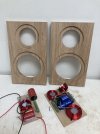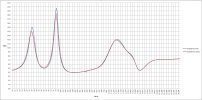Anyone care to convince me
not to use a slotted port rather than the stock Monacor port?
"problem" to be solved:
- seems to be a consensus (several posts, earlier in thread) that the port design could be improved
- larger port is desirable, but the corresponding longer length req'd doesn't fit "easily" in the cabinet
benefit of a slotted port:
- can increase port cross sectional area and port length without the internal interference issues facing a typical round tube
disadvantages of a slotted port:
- requires more complex cabinet construction
- lower port "performance" due to increased surface area of slot vs cylinder (?? I know this is theoretically true, but I don't know if it really has practical consequence)
The added degree of difficulty in the cabinet construction isn't a concern for me, so it seems worth pursuing. UNLESS I'm overlooking things, which I trust others here will point out!

I see two obvious placement options for the slot:
1) Back of cabinet, at bottom. Interior port would go directly up the back panel. This has the benefit of maintaining exact front baffle dimensions.
2) Front of cabinet, at bottom. Interior port would go across the bottom panel, and can continue up the back panel if necessary for length. Changes baffle height, but only below the woofer in the least critical area.
In both cases, cabinet depth can be adjusted to maintain effective interior cabinet volume as necessary.
I'm leaning toward a 1.5cm tall slot at bottom of front baffle, with "tube" created by adding a single 207mmx138mmx18mm bracing panel inside the cabinet (a "false floor" 1.5cm above the cabinet base, glued to the baffle and side panels, but back edge stopping 2cm shy of the back panel), The resulting port is ~ 20cm2 area X 225mm length, which is roughly equivalent to the MBR-50 port & tuning proposed by
@Maiky76 in post #91
here .
The cabinet would gain 3.3 cm in height. Does anyone think this extension below the woofer will have meaningful consequence?
Are there inherent problems w/ slot ports that I'm overlooking?



